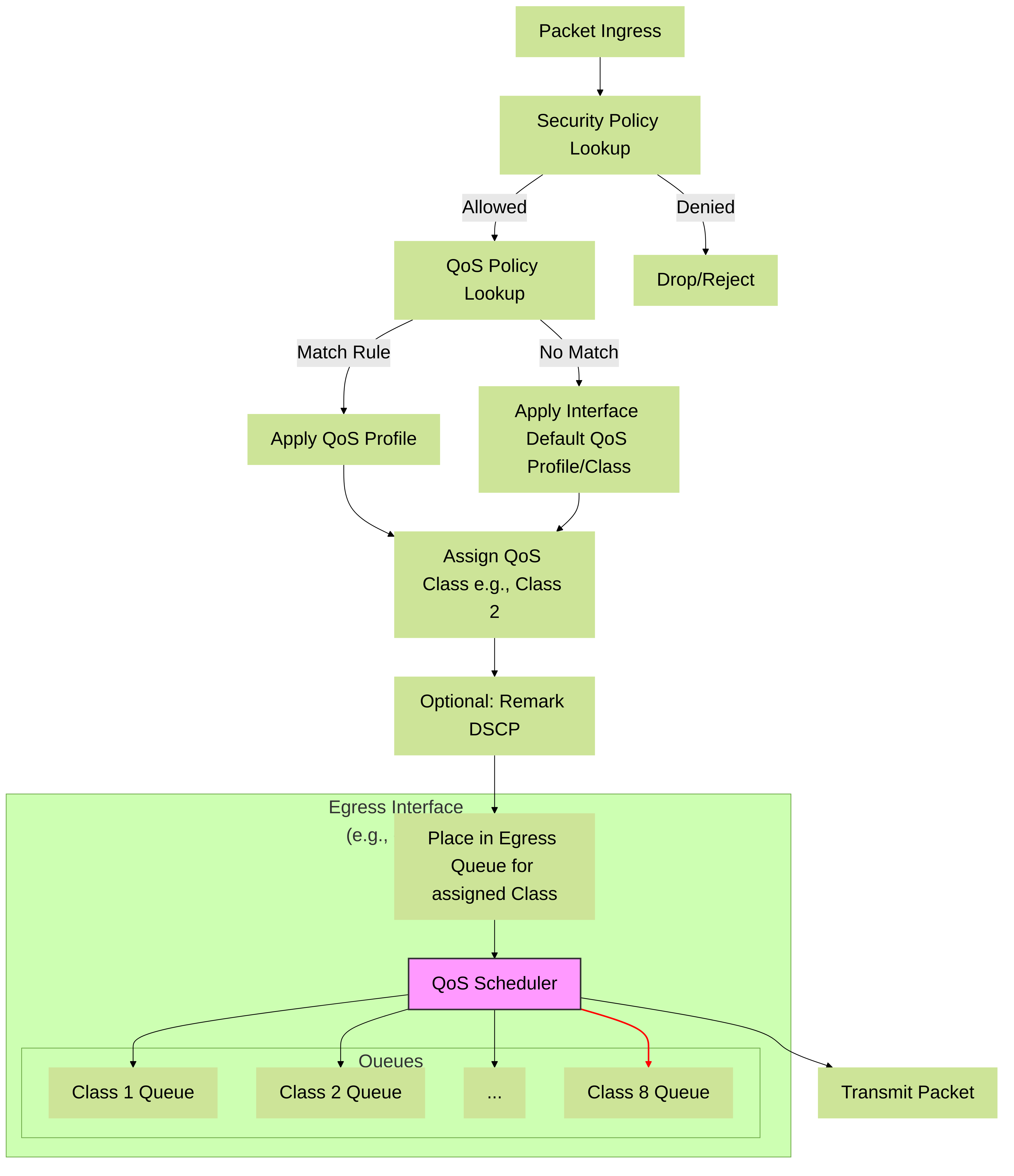-
Interface Configuration:
Administrator enables QoS on the egress interface (e.g.,
ethernet1/1), defines its totalEgress Maxbandwidth, and allocatesGuaranteedandMaximumbandwidth limits for each of the 8 QoS classes. -
Profile Creation:
Administrator creates QoS Profile objects (e.g.,
Profile-VoIPmaps toClass 2,Profile-Webmaps toClass 4,Profile-Bulkmaps toClass 6). -
Policy Creation:
Administrator creates QoS Policy rules.
-
Rule 1: Matches VoIP application traffic, applies
Profile-VoIP. -
Rule 2: Matches web-browsing application traffic, applies
Profile-Web. -
Rule 3: Matches file-transfer application traffic, applies
Profile-Bulk. -
(Default): Traffic not matching Rules 1-3 uses the interface's default profile (e.g., mapping to
Class 4).
-
Rule 1: Matches VoIP application traffic, applies
-
Traffic Processing:
- A packet arrives at the firewall.
- Security Policy allows the packet.
- QoS Policy lookup occurs (top-down). A matching rule is found (e.g., Rule 1 for a VoIP packet).
-
The associated QoS Profile (
Profile-VoIP) is applied, marking the packet internally forClass 2treatment. - If the profile includes DSCP remarking, the IP header is modified.
-
As the packet prepares to leave the egress interface (
ethernet1/1), it's placed into the queue forClass 2. - The interface's QoS scheduler dequeues packets based on strict priority (Class 1 first, then Class 2, etc.), respecting the configured guaranteed/maximum bandwidth limits for each class during periods of congestion.
QoS Policy vs. QoS Profile: Understanding the Difference
It's crucial to understand the distinct roles of QoS Policy rules and QoS Profile objects, as they work together but serve different functions:
-
QoS Policy Rule (
Policies > QoS):- Purpose: To identify and match specific traffic flows based on criteria like zones, addresses, users, applications, services, or incoming DSCP values.
- Action: Its primary action is to apply a specific QoS Profile to the traffic it matches. Think of it as the "classifier" or "selector".
- Evaluation: Evaluated top-down, first match, similar to Security Policies.
- Analogy: Like a Security Policy rule that matches traffic and decides to "Allow + Apply Antivirus Profile", a QoS Policy rule matches traffic and decides to "Apply QoS Profile X".
-
QoS Profile Object (
Objects > QoS Profile):- Purpose: To define the specific QoS treatment that should be applied to traffic.
- Action: Its core function is to assign the traffic to one of the 8 QoS Classes . It can optionally also define DSCP/ToS remarking values.
- Role: It's an object that contains the treatment definition; it doesn't match traffic itself.
- Analogy: Continuing the analogy, the QoS Profile is like the "Antivirus Profile" – it defines *what* inspection/treatment (in this case, which QoS Class) happens once the policy rule has matched the traffic.
In summary: The QoS Policy rule asks "*Which* traffic gets QoS?", while the associated QoS Profile object answers "*What* class (and maybe DSCP marking) should that traffic receive?". You need both configured correctly, along with the interface QoS settings, for QoS to function.
Quick Comparison Table:
| Attribute | QoS Policy Rule | QoS Profile Object |
|---|---|---|
| Primary Goal | Identify/Match Traffic | Define QoS Treatment |
| Location |
Policies > QoS
|
Objects > QoS Profile
|
| Key Action | Apply a QoS Profile (or directly remark DSCP) | Assign QoS Class (1-8) |
| Configuration Focus | Matching Criteria (Zones, IPs, Apps, Users, Services, DSCP) | QoS Class selection, Optional DSCP/ToS Remarking |
| Dependency | Requires a QoS Profile (or direct remarking) to apply | Is applied *by* a QoS Policy rule or as an Interface Default |
Clarification: Where is the "QoS Profile" Applied?
Important Point of Clarity: The term "QoS Profile" can be confusing because it's used in two distinct contexts within the PAN-OS configuration. Understanding where each is applied is key:
-
Interface QoS Settings (Sometimes called Network QoS Profile):
- What it is: This configuration defines the overall QoS behavior for a specific physical or aggregate interface . It sets the total egress bandwidth limit for the interface and, critically, allocates the guaranteed and maximum bandwidth for each of the 8 QoS classes on that specific interface . It also defines the default QoS class for traffic not matching any QoS policy rule on that interface.
-
Configuration Location:
Network > Interfaces > [Select Interface] > QoStab OR viaNetwork > Network Profiles > QoS Profile(where you create a profile that is then *assigned* to one or more interfaces). - Applied To: This profile/configuration is applied directly TO THE EGRESS INTERFACE . It controls the resources and queuing behavior *on that interface*.
-
QoS Profile Object:
- What it is: This is an object you create primarily to map traffic to one of the 8 QoS Classes . It can also optionally include DSCP remarking settings.
-
Configuration Location:
Objects > QoS Profile -
Applied To:
This profile object is selected as the
ACTION within a QoS Policy Rule (
Policies > QoS) . When a QoS policy rule matches traffic, it applies the settings defined in this QoS Profile object *to that matched traffic*, primarily telling the system which QoS Class that traffic belongs to.
In essence:
- You configure the bandwidth allocation and queuing rules per class by applying settings/profile TO the interface .
- You classify traffic and assign it TO a specific class by applying a QoS Profile object VIA a QoS Policy rule .
Both are needed for QoS to function: the interface needs its class bandwidths defined, and policies need to assign traffic to those classes using the QoS Profile objects.
Simplified Analogy:
- Interface QoS Settings: Like setting up 8 different priority lanes on a highway exit ramp (the interface) and defining how much total traffic (Egress Max) and how much guaranteed/max traffic each lane (QoS Class) can handle.
- QoS Policy Rule: Like a traffic controller looking at specific vehicles (traffic matching application, user, etc.).
- QoS Profile Object: The instruction the traffic controller gives ("You [matched traffic], go into Lane 3 [QoS Class 3]!").
 Simplified QoS processing flow.
Simplified QoS processing flow.